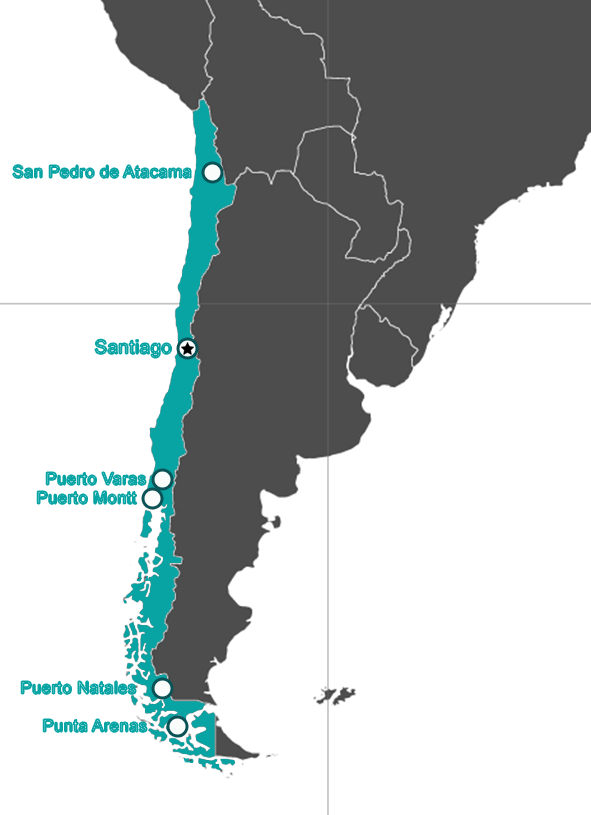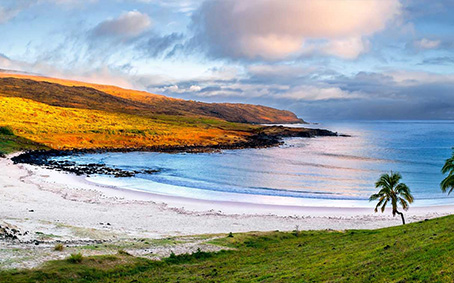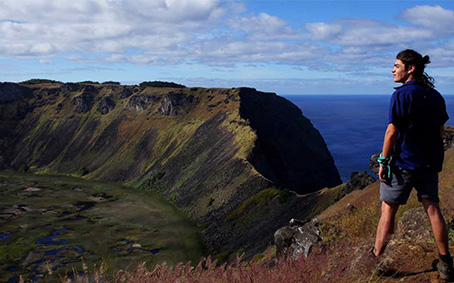Chile . Isla de Pascua
Pasaporte: la entrada es generalmente directa siempre que el pasaporte sea válido durante al menos seis meses después de la fecha de llegada.
Reglamento aduanero: sin restricciones a la importación y exportación de moneda local y extranjera. Las asignaciones libres de impuestos incluyen compras de hasta US$ 500. Los viajeros que salen de las Regiones I y XII libres de impuestos están sujetos a inspecciones aduaneras internas; hay fuertes multas para frutas, lácteos, especias, nueces, carne y productos orgánicos. Las máquinas de rayos X se utilizan en los principales cruces fronterizos internacionales, como Los Libertadores (el cruce desde Mendoza, Argentina) y Pajaritos (el cruce desde Bariloche, Argentina).
Visas: generalmente no se requieren para estadías de hasta 90 días. Los ciudadanos australianos deben pagar una "tarifa de reciprocidad" al llegar por vía aérea.
Tarjetas de turista: al llegar a Chile los visitantes recibirán una tarjeta de turista de 90 días en forma de recibo con código de barras, que se les pedirá al salir del país. Si bien es posible renovarla por 90 días más, muchos visitantes prefieren una viaje rápido a través de la frontera argentina y viceversa.
Electricidad: la corriente eléctrica funciona a 220V, 50Hz; los enchufes son de tipo C / L.
Horario: durante la mayor parte del año Chile está 4 horas detrás de GMT, pero desde mediados de diciembre hasta finales de marzo, debido al horario de verano la diferencia es de 3 horas (la fecha exacta del cambio varía de año en año). Para tener en cuenta: la Patagonia austral usa el horario de verano durante todo el año y la Isla de Pascua está 2 horas detrás de Santiago.
Acceso a Internet: la mayoría de las regiones tienen excelentes conexiones a Internet. Es típico que los hoteles, hostales y cafeterías tengan wifi excepto en gran parte de la Patagonia aunque puede haber conexión Wi-Fi pública gratuita disponible en algunas comunidades.
Teléfonos móviles: los viajeros extranjeros con teléfonos celulares desbloqueados solo pueden usar una tarjeta SIM chilena después de registrar su propio dispositivo en Chile. Las tarjetas SIM locales son baratas y están ampliamente disponibles, para usar con teléfonos GSM 850/1900 desbloqueados. Hay acceso 3G o 4G en los centros urbanos. Los números de teléfono celular tienen nueve dígitos, comenzando con 9. Si se llama de un celular a un teléfono fijo, se debe usar el código de área del teléfono fijo. Los teléfonos celulares tienen el formato "quien llama paga". Las llamadas entre teléfonos celulares y fijos son caras y consumen rápidamente los montos de las tarjetas prepagas. Hay que comprar una nueva tarjeta SIM de un operador chileno como Entel o Movistar y luego comprar crédito telefónico del mismo operador en quioscos, farmacias o cajas de supermercados. En Patagonia, Entel tiene una cobertura mucho mejor que otras compañías. Hay recepción en la mayoría de las áreas habitadas, aunque es más pobre en el medio del desierto de Atacama y algunas partes de la Patagonia.
Dinero: los cajeros automáticos están ampliamente disponibles, excepto a lo largo de la Carretera Austral. Se aceptan tarjetas de crédito en hoteles de alta gama, algunos restaurantes y tiendas. Los cheques de viajero no son ampliamente aceptados.
Cajeros automáticos: los muchos cajeros automáticos de Chile, conocidos como Redbanc, son la forma más fácil y conveniente de acceder al efectivo. Las tarifas de transacción pueden ser altas. La mayoría de las máquinas tienen instrucciones en español e inglés. Elija la opción tarjeta extranjera antes de comenzar la transacción. En toda la Patagonia, muchos pueblos pequeños solo tienen un banco. Aquellos que crucen por tierra desde El Chaltén, Argentina a Villa O'Higgins deben traer muchos pesos chilenos, ya que los bancos confiables más cercanos están en Coyhaique.
Efectivo: algunos bancos y casas de cambio intercambiarán moneda extranjera, usualmente solo dólares estadounidenses. Las compras más costosas, como los tours y las facturas de hotel, a veces se pueden pagar en dólares estadounidenses en efectivo.
Tarjetas de crédito: el plástico (especialmente Visa y MasterCard) es bienvenido en la mayoría de las empresas establecidas; sin embargo, muchas empresas cobrarán hasta un 6% adicional para cubrir el cargo que tienen que pagar por la transacción. Las tarjetas de crédito también pueden ser útiles para mostrar 'fondos suficientes' antes de ingresar a otro país sudamericano.
Moneda: la unidad de moneda chilena es el peso (CH$). Los billetes de banco vienen en denominaciones de 500, 1000, 2000, 5000, 10,000 y 20,000 pesos. Los valores de las monedas son 1, 5, 10, 50, 100 y 500 pesos, aunque las monedas de 1 peso están desapareciendo rápidamente, e incluso 5 y 10 son poco comunes. Es importante llevar billetes pequeños; también puede ser difícil cambiar billetes grandes en las zonas rurales.
Propinas: se acostumbra dar una propina del 10% de la factura en los restaurantes (la factura puede incluirla en "servicio"). Los conductores de taxis no requieren propinas.
Impuestos y reembolsos: se aplica un impuesto al valor agregado del 19% conocido como (IVA) sobre todos los bienes y servicios. Al utilizar dólares estadounidenses o una tarjeta de crédito extranjera para pagar el alojamiento o los paquetes turísticos, no se cobra IVA ni impuestos.
Horario comerciales: se detallan aquí los de temporada alta; en muchas ciudades y pueblos provinciales, los restaurantes y servicios están cerrados los domingos y las oficinas de turismo cierran en temporada baja.
Bancos de 9 a 14 hs de lunes a viernes, a veces de 10 a 13 hs
Los museos a menudo cierran los lunes
Restaurantes desde el mediodía hasta la 23 hs, muchos cierran de 16 a 19 hs
Tiendas de 10 a 20 hs, algunas cierran de 13 a 15 hs
El país más largo y delgado del mundo se extiende entre la Cordillera de los Andes y el Océano Pacífico. Además de compartir fronteras con Argentina, Perú y Bolivia, Chile también posee territorio en la Polinesia y la Antártica, transformándose en una nación tri-continental. Desde el altiplano hasta los inexplorados territorios australes del fin del mundo, Chile invita a vivir aventuras en medio del desierto más árido del mundo, del único bosque templado lluvioso de Sudamérica, frente a glaciares milenarios o bajo la atenta mirada de la imponente Cordillera de los Andes en medio del movimiento de modernas ciudades como su capital, Santiago. Estos contrastes culturales y climáticos han marcado la identidad del país y su gente. Cálidos, enérgicos, cercanos y amables, los chilenos comparten el amor por su tierra, que invita a construir vínculos más allá de las distancias, a vivir experiencias únicas, a descubrir Chile.
Población: 18,1 millones.
Capital: Santiago.
Nacionalidades y etnias: 90% Mestizos, 5% Indios, 5% descendientes de Europeos.
Idioma: Español y numerosas lenguas nativas, como el aymará, el mapuche y el rapa nui.
Religión: 89% católicos, 10% protestantes, menos del 1% judíos.


